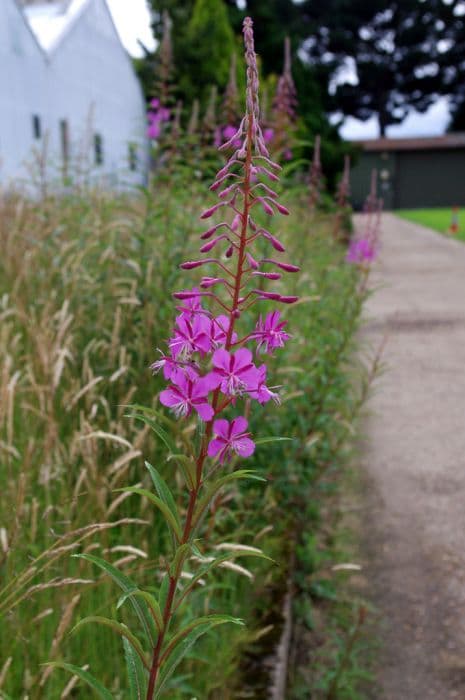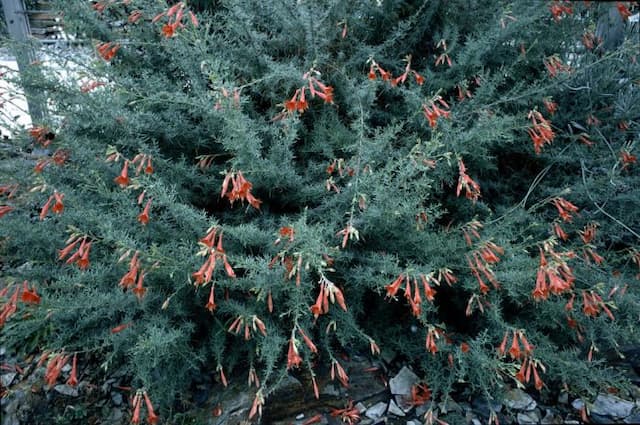Fuchsia Fuchsia 'Katrina Thompsen'

ABOUT
Fuchsia 'Katrina Thompsen' is an ornamental plant renowned for its vibrant and attractive flowers. The blossoms are distinctively pendulous, featuring a striking combination of colors. Typically, the outer parts of the flower, known as the sepals, are long and slender with a bold pink to reddish hue. Harmonizing beautifully with the sepals, the inner petals, also referred to as the corolla, display a deep purple or violet shade, often creating a two-tone effect that is eye-catching. The flowers are usually quite dainty and hang from the plant gracefully, which can give the plant a somewhat elegant, cascading appearance. This characteristic makes Fuchsia 'Katrina Thompsen' popular for use in hanging baskets or as a potted display on balconies and patios where their trailing habit can be admired. Aside from the enchanting flowers, the foliage adds to the plant's allure. The leaves are typically oval or elongated with a slight serration along the edges, providing a lush, green backdrop that contrasts with the bright blossoms. The stems are slender and may have a slight arch, supporting the drooping flowers and emphasizing their ornate presentation. Overall, the combination of its striking flowers and pleasant greenery makes Fuchsia 'Katrina Thompsen' a favorite among gardeners and those who appreciate the beauty of flowering plants.
About this plant
 Names
NamesFamily
Onagraceae
Synonyms
Ladies' Eardrops, Fuchsia
Common names
Fuchsia 'Katrina Thompsen'.
 Toxicity
ToxicityTo humans
Fuchsia plants, including the cultivar 'Katrina Thompsen', are generally considered non-toxic to humans. They do not typically pose a risk of poisoning when touched or ingested. Therefore, eating parts of the plant is not expected to cause severe symptoms or consequences. However, it is always advisable for individuals to refrain from eating ornamental plants as a precaution, and to seek medical advice if any adverse reactions occur after handling or consuming plant material.
To pets
Fuchsia, including the 'Katrina Thompsen' variety, is also considered to be non-toxic to pets. It is not known to cause any serious ill effects if pets ingest parts of the plant. Nonetheless, it is always a good practice to prevent pets from eating non-food plants since individual animals might have unique sensitivities, and ingesting non-food items can sometimes lead to gastric upset or other digestive issues. If you notice any abnormal signs after your pet has ingested fuchsia, it is best to consult with a veterinarian.
 Characteristics
CharacteristicsLife cycle
Perennials
Foliage type
Deciduous
Color of leaves
Green
Flower color
Mixed
Height
2 feet 4 inches [70 cm]
Spread
2 feet 4 inches [70 cm]
Plant type
Shrub
Hardiness zones
9
Native area
Central America
Benefits
 General Benefits
General Benefits- Ornamental Value: Adds visual interest with its attractive and colorful hanging flowers, enhancing the aesthetic of gardens and landscapes.
- Hummingbird Attraction: Its vibrant flowers are known to attract hummingbirds, which can help pollinate other plants and add life to the garden.
- Shade Tolerance: Capable of growing in partially shaded areas, providing versatility for gardeners with less sun exposure.
- Continuous Blooming: Often produces blooms throughout the growing season, offering a long-lasting display of color.
- Container Gardening: Suitable for pots and hanging baskets, making it ideal for balconies and patios.
- Variety of Uses: Can be used in mixed borders, as a standalone specimen, or in mass plantings for a dramatic effect.
- Easy Pruning: Responds well to pruning, which allows for control over its size and shape and encourages more prolific blooming.
- Breeding Potential: Offers opportunities for breeding and hybridization, providing a potential hobby for enthusiasts.
- Availability: Widely available and comes in many cultivars, giving gardeners a variety of choices for their specific needs.
 Medical Properties
Medical PropertiesThis plant is not used for medical purposes.
 Air-purifying Qualities
Air-purifying QualitiesThis plant is not specifically known for air purifying qualities.
 Other Uses
Other Uses- Fuchsia can be used to create natural dyes. The flowers and berries of the fuchsia plant can be boiled to extract a purple or pink dye for fabrics.
- Culinary garnish. The edible flowers of the fuchsia plant can add a pop of color and a slightly tangy flavor to salads and desserts.
- Bonsai. Fuchsia plants can be trained as bonsai for a unique take on this traditional Japanese art form.
- Insect attractant. Fuchsia plants can be strategically placed to attract hummingbirds and pollinators such as bees and butterflies to your garden.
- Photography subject. The vivid colors and unique shapes of fuchsia blooms make them an excellent subject for photographers interested in plant and macro photography.
- Educational use. Fuchsias can be used in educational settings to teach children or gardening enthusiasts about plant growth and botany.
- Creative crafts. The blossoms of the fuchsia plant can be used in flower pressing, which can then be utilized in crafting bookmarks, greeting cards, or framed art.
- Floral arrangements. Fuchsia stems can be incorporated into bouquets or floral displays to add a dramatic cascading effect.
- Habitat enhancement. By planting fuchsia in a garden, you can provide shelter and food for wildlife, contributing to biodiversity.
- Theme gardens. Fuchsia can be a star plant in a Victorian-themed garden, their historical period of peak popularity offering an authentic touch.
Interesting Facts
 Feng Shui
Feng ShuiThe Fuchsia is not used in Feng Shui practice.
 Zodiac Sign Compitability
Zodiac Sign CompitabilityThe Fuchsia is not used in astrology practice.
 Plant Symbolism
Plant Symbolism- Confidence: Fuchsia flowers stand out with their unique shape and vibrant colors, symbolizing confidence and individuality.
- Elegance: The graceful droop of the fuchsia blooms represents elegance and good taste.
- Ardor: Fuchsia flowers are often associated with overflowing enthusiasm or passion due to their vivid colors and vigorous growth.
- Good news: In Victorian times, fuchsias were considered a harbinger of good news coming your way, as their flowers were seen as a sign of positive things to unfold.
- Trust: Due to their reliable growing patterns and long flowering season, fuchsias can symbolize trust and consistency.
 Water
WaterFuchsias, including 'Katrina Thompsen', prefer consistently moist soil, so it's important to water them when the top inch of soil feels dry to the touch. Generally, this will mean watering about once or twice a week, but this frequency can vary depending on temperature and humidity levels. During hot weather, they may require more frequent watering. It's best to water deeply, providing enough water so that it runs through the drainage holes at the bottom of the pot—typically, this would be about 1 to 2 gallons for a medium-sized hanging basket every week during the growing season. In cooler weather or when the plant is not actively growing, reduce watering to prevent soggy soil, which can lead to root rot.
 Light
LightFuchsias like 'Katrina Thompsen' thrive in bright, indirect light with protection from harsh afternoon sun. The ideal location would be a spot that receives morning sunlight and dappled shade in the afternoon. They can also perform well in an eastern-facing location where they get gentle morning sun which is less intense. Avoid placing them in deep shade as this can lead to poor flowering and leggy growth.
 Temperature
TemperatureFuchsias, including 'Katrina Thompsen', perform best in cool to moderate temperatures with daytime highs around 60 to 75 degrees Fahrenheit and nighttime lows not dipping below 50 degrees Fahrenheit. They can handle a brief period of temperatures slightly outside this range, but prolonged exposure to temperatures above 80 degrees Fahrenheit or below 40 degrees Fahrenheit can be harmful to the plant. It's best to ensure they are in conditions that are as close as possible to these ideal temperature ranges for optimal growth.
 Pruning
PruningPruning Fuchsias like 'Katrina Thompsen' encourages a bushy growth habit and more prolific blooming. Prune in the early spring before new growth begins by cutting back about a third of the plant to maintain shape and remove any dead or weak branches. Deadheading or removing spent flowers regularly throughout the growing season will also promote continuous blooming. The best time for major pruning is late winter or early spring, just before the plant breaks dormancy.
 Cleaning
CleaningAs needed
 Soil
SoilFuchsia 'Katrina Thompsen,' commonly known as Hardy Fuchsia, thrives in a soil mix that is rich, moist, and well-draining, with a pH between 6 and 7. A mixture of loam, peat moss, and sand in equal parts is ideal to provide the necessary drainage and nutrient retention. Incorporating a slow-release fertilizer can also benefit the plant's growth and flowering.
 Repotting
RepottingHardy Fuchsia should generally be repotted every two to three years to refresh the soil and accommodate root growth. It's best done in the spring before the growing season begins. If the plant shows signs of being pot-bound, with roots circling the bottom of the pot, it may need repotting more frequently.
 Humidity & Misting
Humidity & MistingHardy Fuchsias prefer moderate to high humidity levels for optimal growth. The best range for these plants is between 60% and 70% relative humidity. Maintaining these conditions will help ensure healthy foliage and promote vibrant blooms.
 Suitable locations
Suitable locationsIndoor
Place Hardy Fuchsia in bright, indirect light; keep soil moist.
Outdoor
Plant in dappled shade, shelter from strong winds, keep soil moist.
Hardiness zone
6-9 USDA
 Life cycle
Life cycleThe life cycle of the Fuchsia 'Katrina Thompsen', commonly known as Hardyal Fuchsia, begins with seed germination, where warmth and moisture trigger the development of the primary root and shoot. After germination, the seedling stage is characterized by the emergence of cotyledons and the development of true leaves, allowing photosynthesis to begin. As the plant enters the vegetative stage, it experiences rapid growth of stems and leaves, and with appropriate light and nutrition, it matures to set buds. The flowering stage sees the blossoming of the distinctive teardrop-shaped flowers in shades of pink, purple, and white, attracting pollinators for sexual reproduction. Following pollination, the plant produces fleshy fruit containing seeds, which when mature, are dispersed, completing the cycle. In cultivation, Fuchsia 'Katrina Thompsen' can also be propagated vegetatively through cuttings, which root and grow to establish new plants more quickly than seeds.
 Propogation
PropogationPropogation time
Spring-Early Summer
The most popular method of propagation for the Fuchsia 'Katrina Thompsen' is through softwood cuttings, which is typically done in spring or early summer when the plant is actively growing. To do this, a cutting from a healthy, non-flowering shoot of about 2 to 4 inches long (5 to 10 cm) is taken with a sharp, clean knife or scissors. The lower leaves are removed, and the base of the cutting is dipped in a rooting hormone to stimulate root growth. Then, the cutting is inserted into a pot filled with a mixture of peat and perlite or a similar free-draining propagation medium. The pot is covered with a plastic bag or placed in a propagator to maintain high humidity, and kept in bright, indirect light until roots have developed, which typically takes about 3 to 4 weeks. After rooting, the cutting can be potted up into a larger container and gradually acclimated to less humid conditions.









